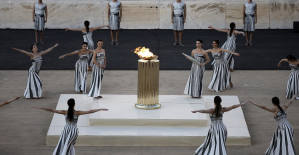After visiting the Ukrainian nuclear power plant at Zaporizhia, the head of the International Atomic Energy Agency (IAEA), Rafael Grossi, raised the alarm in front of the Security Council: "We are playing with fire and something very, very catastrophic could happen." Shelling the buildings is extremely dangerous. Grossi calls for rapid action to be taken against the "unsustainable" situation on the ground - including the establishment of a demilitarized "security zone" around Europe's largest nuclear power plant with six reactor blocks. The report by the IAEA experts on the situation around the Zaporizhia power plant has triggered memories of the accidents in Fukushima and Chernobyl and thus fears in many people.
What is the worst case scenario for the Zaporizhia nuclear power plant?
First of all, it is important to note that, even in the worst case, it is not possible to release such large quantities of radioactive substances as was the case with the Chernobyl reactor disaster in 1986. The reactor types of Zaporizhia and Chernobyl are fundamentally different. The Chernobyl reactors did not have a protective cover - the so-called containment - but only a normal roof. After that was blown away by a hydrogen explosion, the radioactive inventory of the damaged reactor was able to escape upwards unhindered.
The decisive role was played by a graphite fire, which generated great heat and the radioactive substances were catapulted out of the reactor to quite a large height by the chimney effect. From there they could be distributed over great distances by winds. This scenario is unthinkable in Zaporizhia. Should projectiles cause leaks in areas with nuclear inventory, radioactivity would initially only escape locally. How bad that would be in a specific case cannot be answered seriously because it depends on many factors and the relevant processes are very complex. In any case, the release of large amounts of radioactivity into the environment is always a major problem.
So as long as no safety-relevant parts of the nuclear power plant are damaged by projectiles, there is no threat of a nuclear catastrophe?
You can't say it like that. There are other risks. It can be assumed that the staff at the Zaporizhia nuclear power plant are working under a high level of stress given the difficult situation. However, human error is one of the greatest risks in operating a nuclear power plant. Stress-free work is therefore an important prerequisite for safety. Apart from the various technical shortcomings of the Chernobyl reactor type, one must not forget that this accident would not have happened if people had not acted with gross negligence. As part of an experiment, security mechanisms were switched off manually. That was human error.
The IAEA experts emphasize the great importance of the power connections between the Zaporizhia power plant and the supply network. Why is that so important?
Because an interruption in the power supply - in addition to the direct shelling of the power plant - harbors another risk of a nuclear accident. At the moment only reactor No. 6 is still in operation and producing electrical energy. The fuel rods in the shut down reactors and the spent fuel assemblies stored in spent fuel pools must be permanently cooled. This requires pumps and they need electricity so that they can work. As long as reactor No. 6 continues to supply electricity, there is no danger at this point. However, should this reactor also have to be shut down, for example because it was damaged by shelling, the Zaporizhia plant would have to rely on external electricity to continue operating the cooling pumps.
Without cooling, the water-filled cooling basins would dry out after a certain time and radioactivity could be released. However, the spent fuel pools are located inside the reactor building, so there is another barrier before radioactive substances can escape into the environment. But in principle this would be the scenario of Fukushima, where the cooling pumps failed as a result of a tsunami.
How many power lines is the Zaporizhia power plant connected to the supply network?
There are four main lines with a voltage of 750,000 volts each. There are also two reserve lines with 330,000 volts and 150,000 volts. Only when all six lines fail and reactor no. 6 cannot supply electricity itself would there be a problem.
If there were a release of radioactivity into the environment, could Western Europe be affected again - like after the Chernobyl accident?
As I said - even in the worst case, the quantities released would be significantly smaller than in the case of Chernobyl. In addition, they would have a more regional impact on the environment because there would be no chimney effect and transport to higher altitudes in the atmosphere. How far and in which direction radioactive substances would spread from the site of a potential release depends strongly on the current weather conditions, winds and precipitation. Winds that would transport radioactive substances from Ukraine towards Western Europe are rare. In this respect, what happened after the Chernobyl accident was more of an unlikely event, but obviously not impossible.
If the worst comes to the worst, can forecasts be made as to where released radioactive substances will spread?
Yes, there are atmospheric researchers who can make such predictions using dispersion models and the current weather conditions. In addition, there are measuring stations all over Europe and in Germany where increased levels of radioactivity would be registered immediately. A measuring station at a Swedish nuclear power plant provided the first indication of the Chernobyl accident. The wind conditions over Europe had blown part of the "radiant cloud" from Chernobyl to Sweden. It was only later that the detectors also struck in Germany.
Were these measuring stations set up specifically for the case of reactor accidents?
no They primarily serve a different purpose. They serve to monitor the ban on nuclear weapons tests. If an atomic bomb is detonated anywhere in the world, radioactive substances are released into the atmosphere and thus certainly into some of the detectors in this international measurement network.
In view of the tense situation in Zaporizhia, should one stock up on iodine tablets to be on the safe side?
This is not necessary, as there are enough iodine tablets stored for emergencies. In any case, it is not advisable to take such tablets on your own without the specific recommendation. The right timing is also important in order to have a protective effect for the thyroid gland in an emergency. The point is to block this organ with non-radiative iodine so that radioactive iodine can no longer be absorbed. Since iodine is also broken down again in the thyroid gland, it is also possible to take the protective tablet too early. But this is all a very theoretical discussion. It is very, very unlikely that we will be confronted with such an emergency.
Can the two IAEA employees who remained at the Zaporizhia nuclear power plant contribute to the safety of the plant?
Not directly. The two men cannot prevent someone from outside shooting at the power plant or damaging the power lines to the plant. They can also do little to reduce stress among employees. But indirectly they make an important contribution. You can independently observe what is happening on site and thus inform the world public about things that we would otherwise not find out - or only from the perspective of the parties involved. So knowing that there are independent observers on the ground could have a moderating effect on the military actors.
The International Atomic Energy Agency (IAEA) has urged Moscow and Kyiv to set up a protective zone around the Russian-occupied Zaporizhia nuclear power plant in southern Ukraine. WELT correspondent Christoph Wanner on the current situation.
Source: WORLD

 War in Ukraine: when kyiv attacks Russia with inflatable balloons loaded with explosives
War in Ukraine: when kyiv attacks Russia with inflatable balloons loaded with explosives United States: divided on the question of presidential immunity, the Supreme Court offers respite to Trump
United States: divided on the question of presidential immunity, the Supreme Court offers respite to Trump Maurizio Molinari: “the Scurati affair, a European injury”
Maurizio Molinari: “the Scurati affair, a European injury” Hamas-Israel war: US begins construction of pier in Gaza
Hamas-Israel war: US begins construction of pier in Gaza First three cases of “native” cholera confirmed in Mayotte
First three cases of “native” cholera confirmed in Mayotte Meningitis: compulsory vaccination for babies will be extended in 2025
Meningitis: compulsory vaccination for babies will be extended in 2025 Spain is the country in the European Union with the most overqualified workers for their jobs
Spain is the country in the European Union with the most overqualified workers for their jobs Parvovirus alert, the “fifth disease” of children which has already caused the death of five babies in 2024
Parvovirus alert, the “fifth disease” of children which has already caused the death of five babies in 2024 Inflation rebounds in March in the United States, a few days before the Fed meeting
Inflation rebounds in March in the United States, a few days before the Fed meeting Video games: Blizzard cancels Blizzcon 2024, its annual high mass
Video games: Blizzard cancels Blizzcon 2024, its annual high mass Falling wings of the Moulin Rouge: who will pay for the repairs?
Falling wings of the Moulin Rouge: who will pay for the repairs? “You don’t sell a company like that”: Roland Lescure “annoyed” by the prospect of a sale of Biogaran
“You don’t sell a company like that”: Roland Lescure “annoyed” by the prospect of a sale of Biogaran Exhibition: in Deauville, Zao Wou-Ki, beauty in all things
Exhibition: in Deauville, Zao Wou-Ki, beauty in all things Dak’art, the most important biennial of African art, postponed due to lack of funding
Dak’art, the most important biennial of African art, postponed due to lack of funding In Deadpool and Wolverine, Ryan and Hugh Jackman explore the depths of the Marvel multiverse
In Deadpool and Wolverine, Ryan and Hugh Jackman explore the depths of the Marvel multiverse Tom Cruise returns to Paris for the filming of Mission Impossible 8
Tom Cruise returns to Paris for the filming of Mission Impossible 8 Skoda Kodiaq 2024: a 'beast' plug-in hybrid SUV
Skoda Kodiaq 2024: a 'beast' plug-in hybrid SUV Tesla launches a new Model Y with 600 km of autonomy at a "more accessible price"
Tesla launches a new Model Y with 600 km of autonomy at a "more accessible price" The 10 best-selling cars in March 2024 in Spain: sales fall due to Easter
The 10 best-selling cars in March 2024 in Spain: sales fall due to Easter A private jet company buys more than 100 flying cars
A private jet company buys more than 100 flying cars This is how housing prices have changed in Spain in the last decade
This is how housing prices have changed in Spain in the last decade The home mortgage firm drops 10% in January and interest soars to 3.46%
The home mortgage firm drops 10% in January and interest soars to 3.46% The jewel of the Rocío de Nagüeles urbanization: a dream villa in Marbella
The jewel of the Rocío de Nagüeles urbanization: a dream villa in Marbella Rental prices grow by 7.3% in February: where does it go up and where does it go down?
Rental prices grow by 7.3% in February: where does it go up and where does it go down? Even on a mission for NATO, the Charles-de-Gaulle remains under French control, Lecornu responds to Mélenchon
Even on a mission for NATO, the Charles-de-Gaulle remains under French control, Lecornu responds to Mélenchon “Deadly Europe”, “economic decline”, immigration… What to remember from Emmanuel Macron’s speech at the Sorbonne
“Deadly Europe”, “economic decline”, immigration… What to remember from Emmanuel Macron’s speech at the Sorbonne Sale of Biogaran: The Republicans write to Emmanuel Macron
Sale of Biogaran: The Republicans write to Emmanuel Macron Europeans: “All those who claim that we don’t need Europe are liars”, criticizes Bayrou
Europeans: “All those who claim that we don’t need Europe are liars”, criticizes Bayrou These French cities that will boycott the World Cup in Qatar
These French cities that will boycott the World Cup in Qatar Basketball: Strasbourg appeals the victory recovered by Monaco
Basketball: Strasbourg appeals the victory recovered by Monaco Top 14: UBB with Tatafu and Moefana against Bayonne
Top 14: UBB with Tatafu and Moefana against Bayonne MotoGP: Bagnaia dominates qualifying practice in Spain and sets track record
MotoGP: Bagnaia dominates qualifying practice in Spain and sets track record Olympic Games: in Athens, Greece transmits the Olympic flame to France
Olympic Games: in Athens, Greece transmits the Olympic flame to France


















